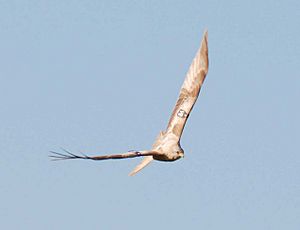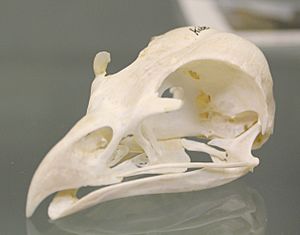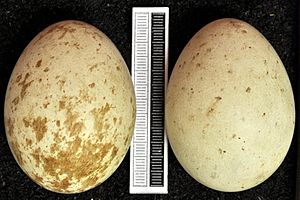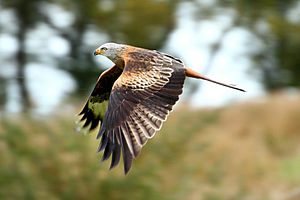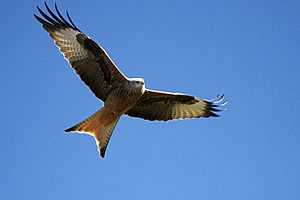Red kite facts for kids
Quick facts for kids Red kite |
|
|---|---|
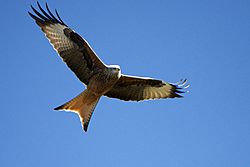 |
|
| Red kite in Spain | |
| Conservation status | |
| Scientific classification | |
| Kingdom: | |
| Class: | |
| Order: | |
| Family: | |
| Subfamily: | |
| Genus: |
Milvus
|
| Binomial name | |
| Milvus milvus |
|
The red kite (Milvus milvus) is a type of medium-sized bird of prey. It belongs to the Accipitridae family, which also includes other raptors like eagles and buzzards.
These birds live across Europe and northwest Africa. Red kites stay all year in the warmer parts of western Europe and northwest Africa. However, birds from central and northeastern Europe fly further south and west for winter, sometimes reaching Turkey.
Red kites mainly eat small mammals and carrion (dead animals). They almost disappeared from most of Britain, except for a few in south Wales. Farmers used to hunt them. Also, a chemical called DDT harmed them through their prey. Luckily, they have made a great return in England and Scotland after being brought back.
In January 2006, a red kite was seen in London. This was the first time in 150 years! By June 2006, a project called Northern Kites reported that red kites were nesting again in the Derwent Valley, Tyne and Wear.
Contents
All About Red Kites
Red kites are about 60 to 70 cm (23-27 inches) long. They have a huge wingspan of 175 to 179 cm (almost 6 feet!). Males weigh 800-1200 grams, and females are a bit heavier at 1000-1300 grams.
It is a very graceful bird. It soars high on long wings that are held in a 'V' shape, called a dihedral. Its long, forked tail twists as the bird changes direction. The body, upper tail, and wing feathers (called coverts) are a reddish-brown color, known as rufous. The white main flight feathers stand out against the black wing tips and darker secondary feathers.
Males and females look similar, except for their weight. Young red kites have a lighter, buff-colored chest and belly. Their call is a thin, high-pitched sound. There is a rare white form of the red kite, called leucistic. About 1% of chicks in Wales are born with this color. However, these white birds may have a harder time surviving.
How Young Red Kites Differ from Adults
Adult red kites look different from young ones in a few ways:
- Adults are a deeper reddish-brown color. Young birds look more faded.
- Adults have dark streaks on their chest. Young birds have pale streaks.
- Young birds have a tail that is not as deeply forked. It also has a dark band near the end.
- Young birds have pale tips on their wing feathers, forming a thin pale line. Adults only have pale edges on some upper wing feathers.
These differences usually last for most of a bird's first year.
Red Kite Life Cycle
Red kites usually start to breed when they are two years old. Sometimes, they can breed successfully at just one year old. They are monogamous, meaning they stay with one partner. Pairs that live in the same area all year likely stay together through winter. For birds that migrate, they usually find the same nesting spot each year and renew their bond.
The nest is usually built in a large hardwood tree, about 12 to 15 meters (39-49 feet) high. A pair might use a nest from the year before. They might even use an old nest built by a common buzzard. Both the male and female build the nest. The male brings twigs, and the female places them. The nest is lined with grass and sometimes sheep's wool.
Eggs are laid every three days. A clutch usually has one to three eggs, but sometimes four or five. The eggs are white with red-brown spots. They are about 57 x 45 mm in size and weigh about 63 grams. In Britain and central Europe, egg-laying starts in late March. In warmer Mediterranean areas, it begins in early March.
The female mainly incubates the eggs. The male will take over for short times so she can eat. He also brings food to her. Incubation starts when the first egg is laid. Each egg hatches after 31 to 32 days. Since they hatch at different times, a clutch of three eggs takes about 38 days to hatch completely.
Both parents care for the chicks. The female keeps them warm for the first 14 days. During this time, the male brings food to the nest, and the female feeds it to the chicks. Later, both parents bring food to the nest, allowing the chicks to feed themselves.
The young birds start climbing onto branches near their nest when they are about 45 days old. They usually fly for the first time (fledge) when they are 48-50 days old. Sometimes it takes them up to 60-70 days. The young birds stay near the nest for another 15-20 days, still being fed by their parents. Red kites only raise one group of chicks each year. However, if the eggs are lost, the female will lay new ones.
The oldest recorded red kite lived for 25 years and 8 months in Germany. In Britain and Ireland, the record is 23 years and 10 months for a bird found in Wales in 2012.
What Red Kites Eat
Red kites mostly eat small mammals. This includes mice, voles, shrews, young hares, and rabbits. They also eat many types of carrion, like dead sheep and game birds. Sometimes, they catch live birds, and occasionally reptiles or amphibians. Earthworms are an important part of their diet, especially in spring.
In some parts of the United Kingdom, people even feed red kites in their gardens. This helps explain why red kites are now seen in cities. About 5% of homes in these areas give extra food to red kites, mostly chicken.
Because red kites eat dead animals, they are easily harmed by poison. Illegal poisons meant for foxes or crows can accidentally kill protected birds like red kites. There have also been cases where criminals purposely poisoned red kites and other raptors.
In the UK, there have been some unusual stories of red kites taking food from people. This is similar to how gulls sometimes do it. For example, in Marlow, red kites have swooped down to steal sandwiches from people in parks.
Where Red Kites Live and Their Status
Red kites live in broadleaf woodlands, valleys, and near wetlands, up to 800 meters (2,600 feet) high. They are native to the western Palearctic region (Europe, North Africa, and parts of Asia). Europe holds 95% of the world's breeding red kite population, with about 19,000–25,000 pairs.
They breed from Spain and Portugal east into central Europe and Ukraine. They also live north to southern Sweden, Latvia, and the UK, and south to southern Italy. There is also a group of red kites in northern Morocco. Birds from northern areas fly south for winter. They mostly stay in the western part of their breeding range. Some go to eastern Turkey, northern Tunisia, and Algeria.
Between 1990 and 2000, the three largest populations (in Germany, France, and Spain) decreased. These countries have over 75% of the world's red kites. Overall, the species declined by almost 20% in ten years.
The biggest dangers to red kites are poisoning. This can be from illegal direct poisons or from pesticides (chemicals used in farming). This is especially a problem in their wintering areas in France and Spain. Changes in farming also mean less food for them. Other threats include electric shocks from power lines, hunting, trapping, and cutting down forests. Collecting their eggs is also a local problem. They might also face competition from the black kite, which is often more successful.
Images for kids
-
Red kite, falconry Adlerwarte Obernberg am Inn, Upper Austria
-
Nestling red kites, Barnim, Germany
-
Red kites at the feeding station, Laurieston, Scotland.
-
A young red kite in Cookham, Berkshire.
See also
 In Spanish: Milano real para niños
In Spanish: Milano real para niños



